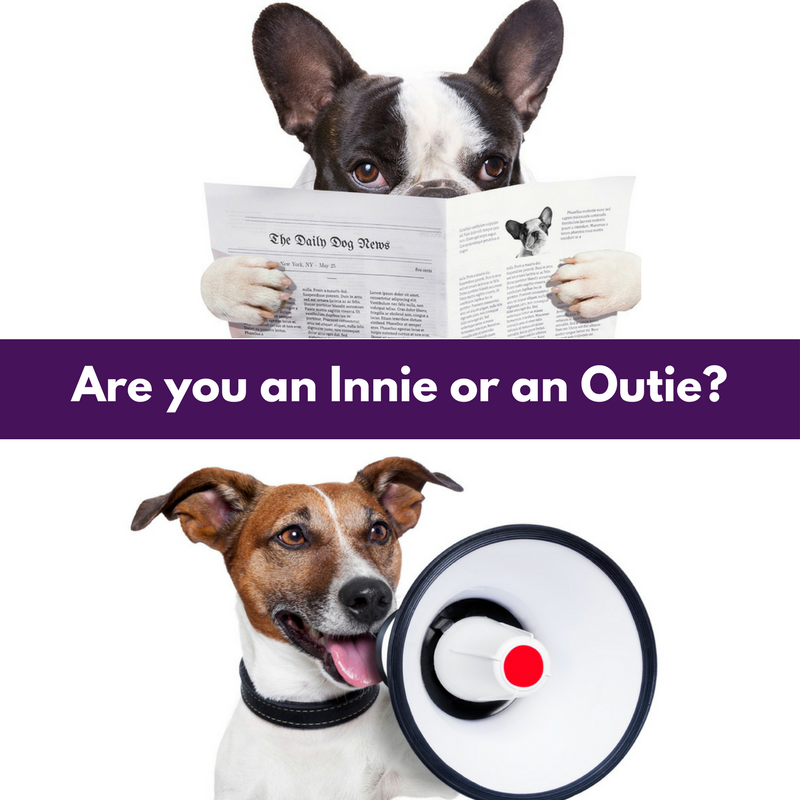
< Back to Insights
Is Your Boss an Innie or an Outie?
Personality preferences drive behavior. At work, it’s easy to feel frustrated by the behaviors of others. When we experience annoying behaviors, we tend to make up stories (usually negative ones) about the reasons behind those behaviors. For example, if our boss prefers to keep his door closed while working, we might conclude that our boss is unfriendly. Which is a story that may or may not be true! So, instead of relying on these reflexive internal stories, we need to open our minds to alternative explanations. Since Managing Up is about optimizing our workplace relationships with bosses and colleagues, it’s helpful to take the time to understand these preferences and drivers. We should take the time to reflect on how different personality preferences impact how we build relationships, communicate and collaborate with others - especially our bosses.
A personality is a multi-faceted, complex construct, so a good place to start is to determine whether your boss is an introvert (Innie) or an extrovert (Outie). Why start here? Well, introversion and extroversion are core personality preferences that significantly impact two things: 1) how we interact with others, and 2) what boosts or drains our energy. Once you determine if your boss is an Innie or an Outie, you can better understand his or her communication style and even more importantly - his or her source of energy, in other words the drivers of their behavior. Communicating well and maintaining positive energy levels is half the battle in any employee-boss relationship.

So, is your boss an Innie or an Outie? Let’s find out!
In reality, the introversion-extroversion preference is more of a continuum than an either/or trait. Even though the rare true “ambivert” does exist, most people do tend to lean towards one side or the other. On the introvert side of the spectrum, we see a focus on the inner world. Introverts draw energy from within (their own thoughts) and prefer less external stimuli (other people). On the opposite end of the spectrum, extroverts respond well to external stimuli and are energized from the people and activity around them.
Communication style is also a hallmark of the introversion-extroversion preference. Introverts tend to prefer less interaction overall and tend to choose written over verbal communication. They are typically slower to respond, hold fewer meetings, and rarely chit-chat. Extroverts enjoy more verbal communication and interaction with others. They usually hold regular meetings, frequently “pop-in” to share ideas, and like to brainstorm or think through choices with others. Here are some additional characteristics of introverts and extroverts:
The Innie Boss
- Shares minimal amount of information
- Listens more than talks
- Often works alone with door closed
- Feels a little closed off and aloof
- Forgets to say hello
- Prefers email to face-to-face conversation
- Rarely thinks out loud
- Doesn’t spend much time networking
- Likes to reflect before taking action
- Check-ins are infrequent
The Outie Boss
- Readily shares information
- Can be long winded
- Checks in regularly
- Feels warm and friendly
- Reveals his/her thought process
- Likes to move to action quickly
- Has a big network
- Prone to thinking out loud
- Solicits opinions
- Works frequently with others
Once you have an idea of which way your boss leans on the introversion-extroversion spectrum, the next step is to compare and reflect on how well your preference aligns with your boss. If you’re not sure where you fall, take our quick Innie or Outie quiz here.
Knowing which way you and your boss lean can help you optimize interactions with your boss. Finding the sweet spot between the Innie-Outie dynamic doesn’t happen overnight - it takes a little effort and willingness to adapt! To move in the right direction, here are our top strategies to work well with your introverted or extroverted boss:
Strategies to Manage Up to the Innie Boss
- Take the initiative to meet. If is often challenging to get some face time with an Innie Boss. To get the mentorship, guidance, and input you need to excel, it is up to you to get on their calendar.
- Give them time to process and prepare. Introverts loathe giving off-the-cuff responses. Don’t catch them off-guard with a question or request. Prior to a meeting, send an email in advance with the topics you’d like to cover or details on a few options that you are considering for a big project.
- Don’t be a chatter box. When you get time with your Innie Boss, use it wisely. Organize your thoughts and get to the point. A little friendly conversation is fine, but a long-winded brainstorming session will quickly drain an introvert.
Strategies to Manage Up to the Outie Boss
- Listen to them talk. Extroverts love interaction and will notice if you are tuning them out. Actively listen to your Outie Boss and show enthusiasm for their ideas. It may cost you a little time and energy, but it is so worth it!
- Speak up! Share your thoughts and participate in meetings – even if you prefer to process and think about options on your own. Your Outie Boss doesn’t expect perfection, just involvement and contribution. Be part of the team and the conversation.
- Clarify and recap. Not everything your Outie Boss says is an action item. Extroverts think out loud and often move on to new projects before old ones are finished. Spend a minute or two at the end of meetings to recap and clarify next steps.
For more tips on understanding your Innie or Outie Boss and to learn about other personality preferences in the workplace, check out Managing Up by Mary Abbajay! Managing Up is available at Amazon, Barnes & Noble, and other book retailers. Get your copy today!
